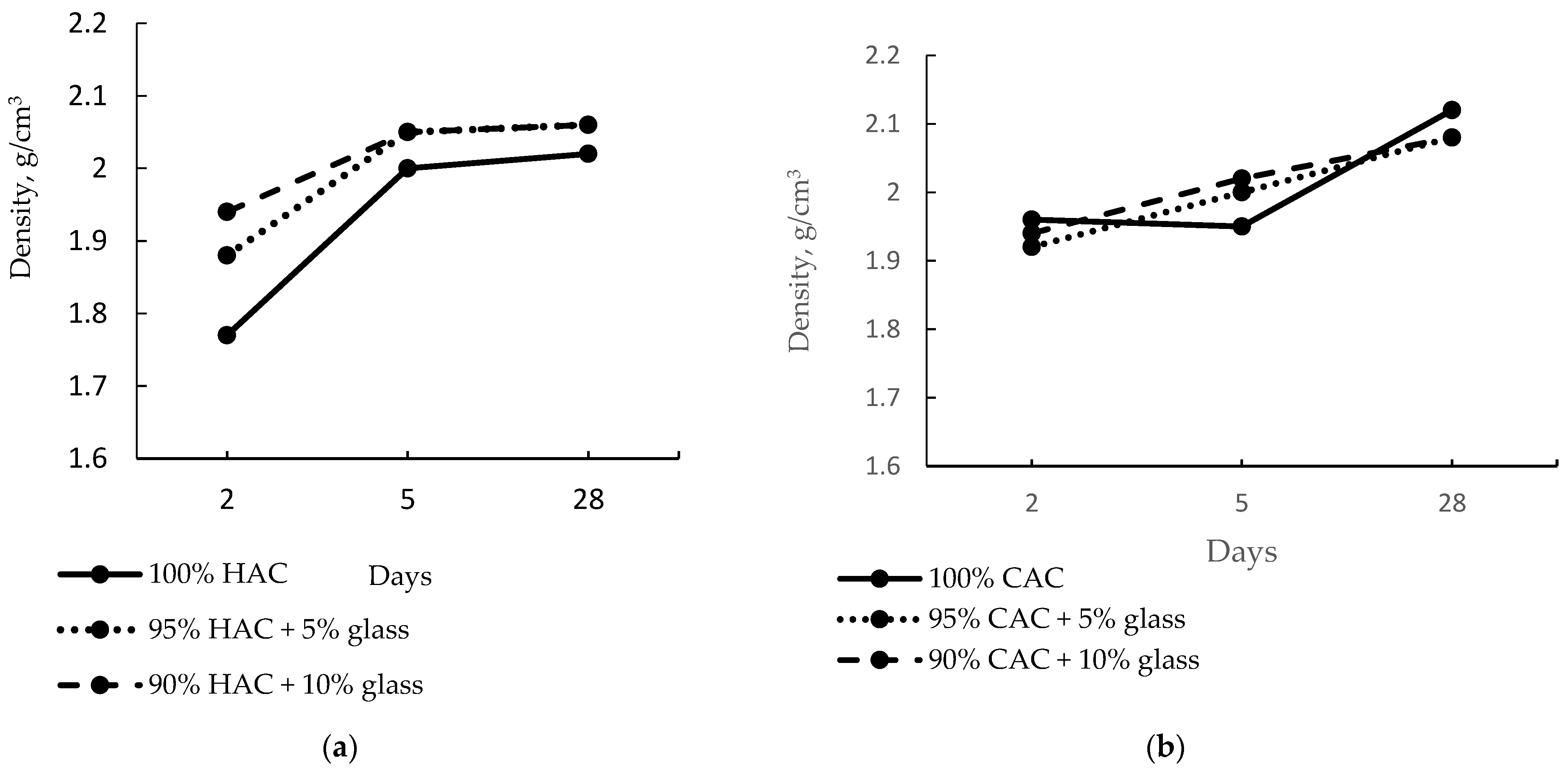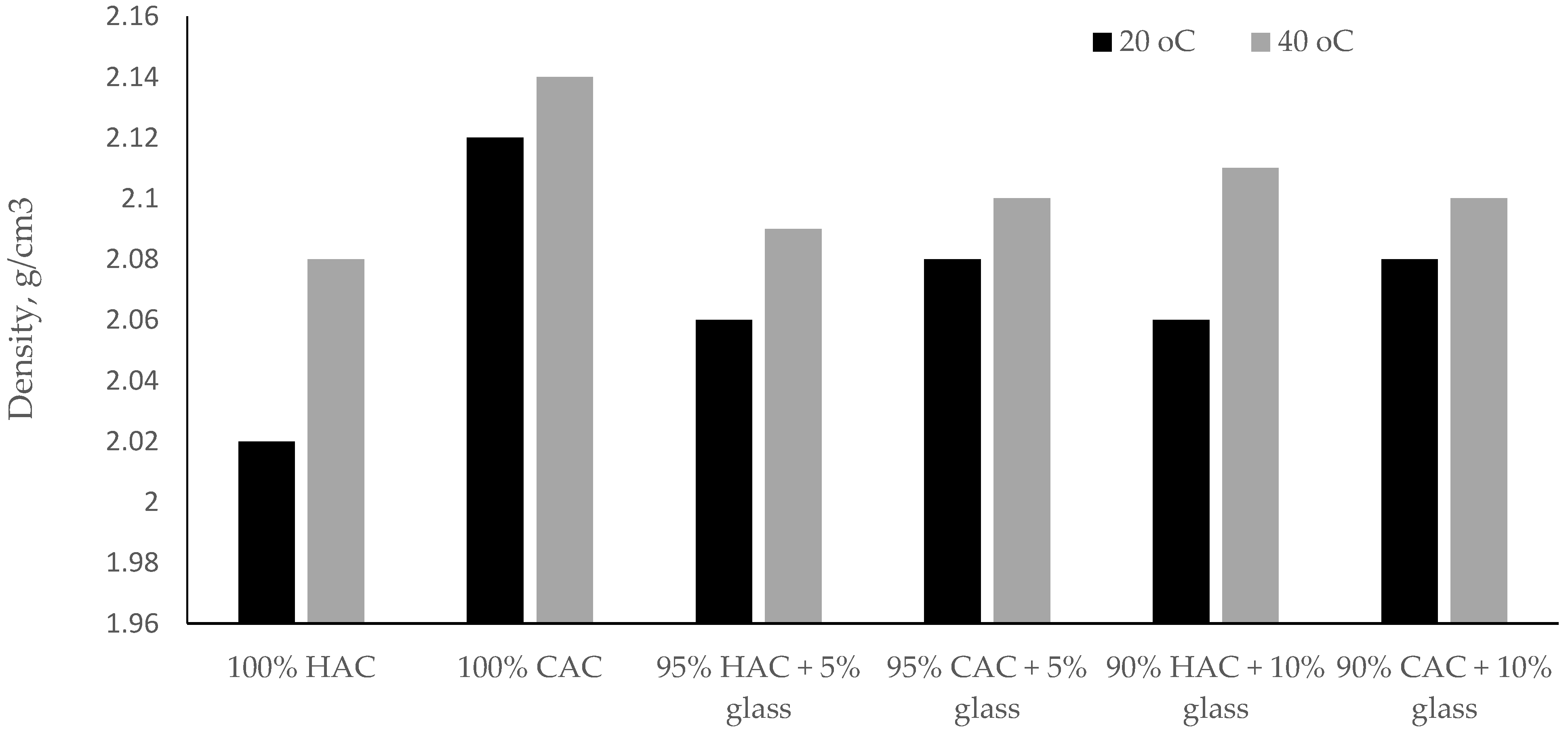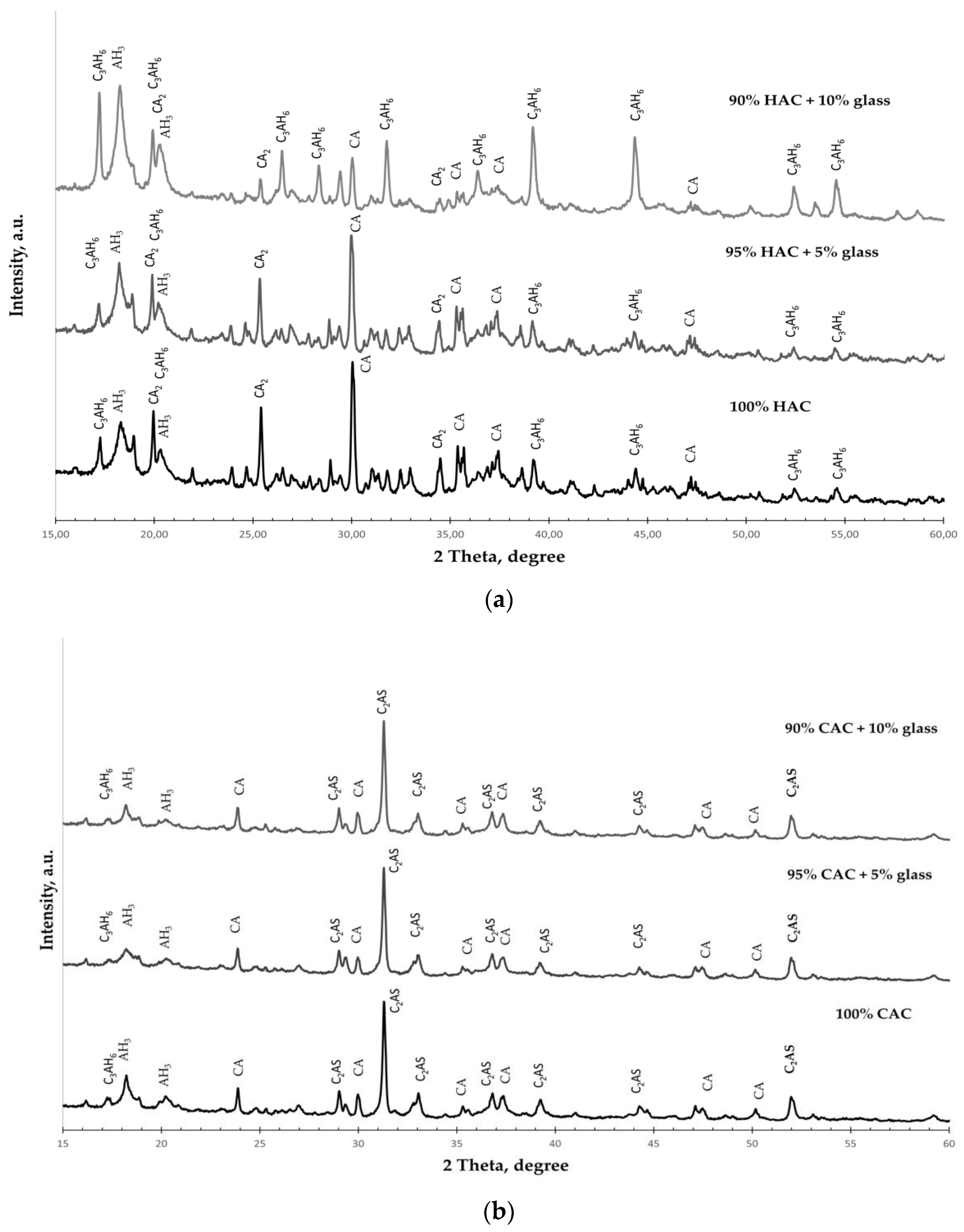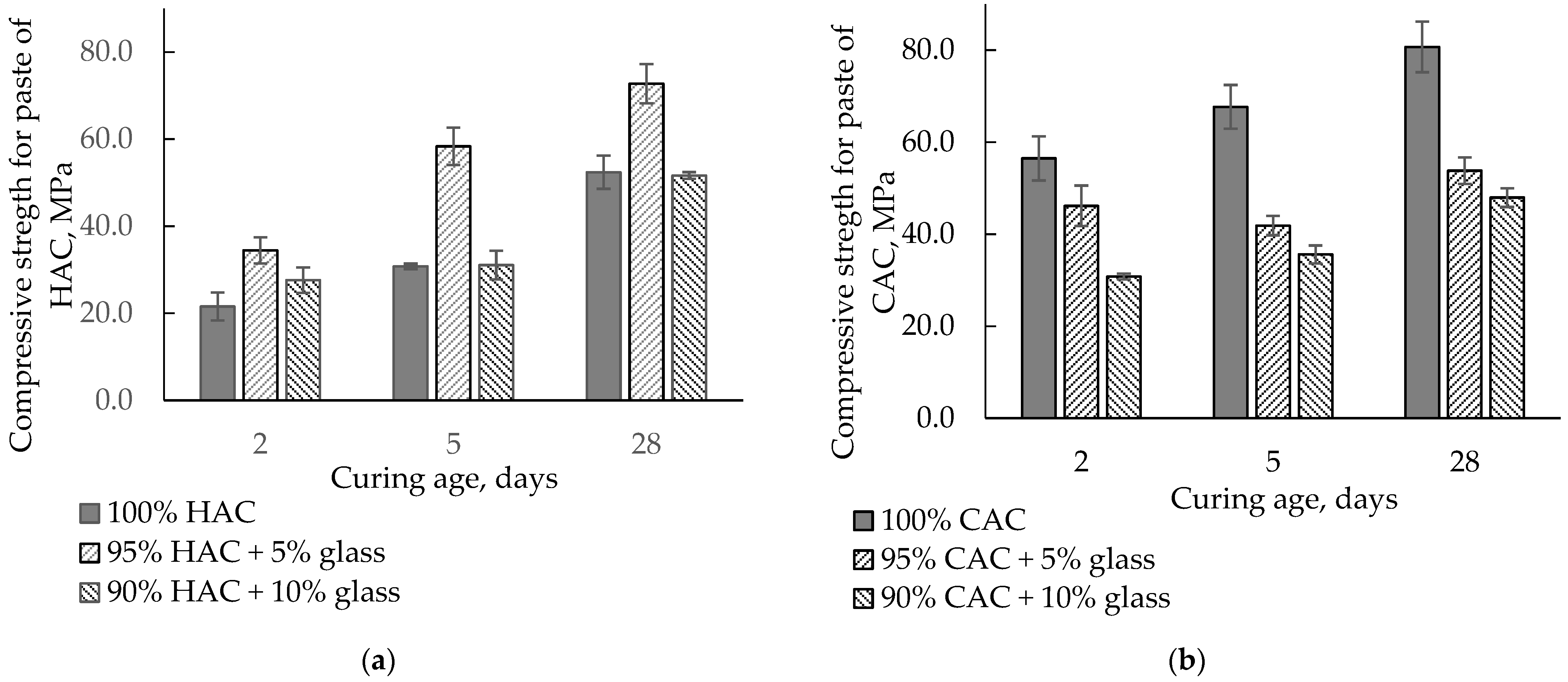The Effect of Fine-Ground Glass on the Hydration Process and Properties of Alumina-Cement-Based Composites
Abstract
:1. Introduction
2. Materials and Methods
3. Results and Discussion
4. Conclusions
Author Contributions
Funding
Institutional Review Board Statement
Informed Consent Statement
Data Availability Statement
Conflicts of Interest
References
- Kurdowski, W. Chemia Cementu i Betonu; Stowarzyszenie Producentów Cementu: Krakow, Poland, 2010. [Google Scholar]
- Peukert, S. Cementy Powszechnego Użytku i Specjalne; Polish Cement: Krakow, Poland, 2000. [Google Scholar]
- Neville, A.M. Właściwości Betonu; Polski Cement: Krakow, Poland, 2012. [Google Scholar]
- Kremieniewski, M.; Stryczek, S. Use of CALCIUM aluminate cements as binders in sealing slurries for drilling technologies. Cement-Wapno-Beton 2019, 24, 215–226. [Google Scholar]
- Khan, H.A.; Castel, A.; Khan, M.S.H.; Mahmood, A.H. Durability of calcium aluminate and sulphate resistant Portland cement based mortars in aggressive sewer environment and sulphuric acid. Cem. Concr. Res. 2019, 124, 105852. [Google Scholar] [CrossRef]
- PN EN 14647:2007 Calcium Aluminate Cement—Composition, Specification and Conformity Criteria; Polish Committee for Standardization: Warsaw, Poland, 2007; p. 33.
- Garcés, P.; Alcocel, E.G.; Chinchón, S.; Andreu, C.G.; Alcaide, J. Effect of curing temperature in some hydration characteristics of calcium aluminate cement compared with those of portland cement. Cem. Concr. Res. 1997, 27, 1343–1355. [Google Scholar] [CrossRef]
- Capmas, D.A.; Sorrentino, D.D. The effect of temperature on the setting time of calcium aluminate cements. In Proceedings of the Calcium Aluminate Cements, E.&F.N. Spon, London, UK, 9–11 July 1990; pp. 65–80. [Google Scholar]
- Lothenbach, B.; Pelletier-Chaignat, L.; Winnefeld, F. Stability in the system CaO–Al2O3–H2O. Cem. Concr. Res. 2012, 42, 1621–1634. [Google Scholar] [CrossRef]
- Bushnell-Watson, S.M.; Sharp, J.H. On the cause of the anomalous setting behaviour with respect to temperature of calcium aluminate cements. Cem. Concr. Res. 1990, 20, 677–686. [Google Scholar] [CrossRef]
- Shinmei, T.; Ohkawa, M.; Iiyama, M.; Wöhrmeyer, C.; Parr, C. The effect of curing temperature of high alumina cement on the crystallization of stratlingite: In the case of curing temperatures of 10 °C and 60 °C. J. Mineral. Petrol. Sci. 2015, 110, 92–95. [Google Scholar] [CrossRef] [Green Version]
- Sakai, E.; Sugiyama, T.; Saito, T.; Daimon, M. Mechanical properties and micro-structures of calcium aluminate based ultra high strength cement. Cem. Concr. Res. 2010, 40, 966–970. [Google Scholar] [CrossRef]
- Quillin, K.; Osborne, G.; Majumdar, A.; Singh, B. Effects of w/c ratio and curing conditions on strength development in BRECEM concretes. Cem. Concr. Res. 2001, 31, 627–632. [Google Scholar] [CrossRef]
- Bensted, J. Scientific aspects of high alumina cement. Cem. Wapno Bet. 2004, 3, 109–133. [Google Scholar]
- Collepardi, M.; Monosi, S.; Piccioli, P. The influence of pozzolanic materials on the mechanical stability of aluminous cement. Cem. Concr. Res. 1995, 25, 961–968. [Google Scholar] [CrossRef]
- Vafaei, M.; Allahverdi, A. Influence of calcium aluminate cement on geopolymerization of natural pozzolan. Constr. Build. Mater. 2016, 114, 290–296. [Google Scholar] [CrossRef]
- Han, B.; Wang, P.; Ke, C.; Yan, W.; Wei, Y.; Li, N. Hydration behavior of spinel containing high alumina cement from high titania blast furnace slag. Cem. Concr. Res. 2016, 79, 257–264. [Google Scholar] [CrossRef]
- Łukasz Kotwica1, P. The infl uence of mineral additives on properties of calcium aluminate cement mortars. Cem. Wapno Bet. 2016, 3, 191–198. [Google Scholar]
- Bensted, J. The influence of pozzolanic materials on the mechanical stability of aluminous cement"by M. Collepardi, S. Morosi, P. Piccioli. Cem. Concr. Res. 1996, 26, 649–650. [Google Scholar] [CrossRef]
- Ding, J. Stratlingite formation in high alumina cement -zeolite systems. Adv. Cem. Res. 1995, 2. [Google Scholar] [CrossRef] [Green Version]
- Majumdar, A.J.; Singh, B. Properties of some blended high-alumina cements. Cem. Concr. Res. 1992, 22, 1101–1114. [Google Scholar] [CrossRef]
- Yang, H.J.; Ann, K.Y.; Jung, M.S. Development of Strength for Calcium Aluminate Cement Mortars Blended with GGBS. Adv. Mater. Sci. Eng. 2019, 2019, 1–12. [Google Scholar] [CrossRef] [Green Version]
- Majchrowicz, I.; Barański, J. The relationship between the properties of low-cement high- alumina castable and microsilica content in the matrix. Sci. Work. Inst. Ceram. Build. Mater. 2013, 12, 51–59. [Google Scholar]
- Kırca, Ö.; Özgür Yaman, İ.; Tokyay, M. Compressive strength development of calcium aluminate cement–GGBFS blends. Cem. Concr. Compos. 2013, 35, 163–170. [Google Scholar] [CrossRef]
- Heikal, M.; Radwan, M.M.; Al-Duaij, O.K. Physico-mechanical characteristics and durability of calcium aluminate blended cement subject to different aggressive media. Constr. Build. Mater. 2015, 78, 379–385. [Google Scholar] [CrossRef]
- Ding, J.; Fu, Y.; Beaudoint, J.J. Effect of different inorganic salts/alkali on conversion-prevention in high alumina cement products. Adv. Cem. Based Mater. 1996, 4, 43–47. [Google Scholar] [CrossRef]
- Ding, J.; Fu, Y.; Beaudoin, J. Effect of Different Zeolites on Conversion-Prevention in High-Alumina Cement Products. ACI Mater. J. 1997, 94, 220–226. [Google Scholar]
- Łukasz Kotwica, K.F. The influence of lithium compounds on alkali—Silica reaction in calcium aluminate cement mortars subjected to the deicing salts attack. Cement-Wapno-Beton 2019, 24, 56–67. [Google Scholar] [CrossRef]
- Walkley, B.; San Nicolas, R.; Sani, M.-A.; Rees, G.J.; Hanna, J.V.; van Deventer, J.S.J.; Provis, J.L. Phase evolution of C-(N)-A-S-H/N-A-S-H gel blends investigated via alkali-activation of synthetic calcium aluminosilicate precursors. Cem. Concr. Res. 2016, 89, 120–135. [Google Scholar] [CrossRef] [Green Version]
- Kotwa, A. Parameters of Alumina Cement and Portland Cement with Addition of Chalcedonite Meal. IOP Conf. Ser. Mater. Sci. Eng. 2017, 245, 032035. [Google Scholar] [CrossRef]
- Duxson, P.; Fernández-Jiménez, A.; Provis, J.L.; Lukey, G.C.; Palomo, A.; van Deventer, J.S.J. Geopolymer technology: The current state of the art. J. Mater. Sci. 2007, 42, 2917–2933. [Google Scholar] [CrossRef]
- González-García, D.M.; Téllez-Jurado, L.; Jiménez-Álvarez, F.J.; Balmori-Ramírez, H. Structural study of geopolymers obtained from alkali-activated natural pozzolan feldspars. Ceram. Int. 2017, 43, 2606–2613. [Google Scholar] [CrossRef]
- Rajczyk, K.; Giergiczny, E.; Szota, M. Microstructure and properties of geopolymeric binders prepared using fly ash. Sci. Work. Inst. Ceram. Build. Mater. 2015, 23, 79–89. [Google Scholar]
- Gao, X.; Yu, Q.L.; Brouwers, H.J.H. Properties of alkali activated slag–fly ash blends with limestone addition. Cem. Concr. Compos. 2015, 59, 119–128. [Google Scholar] [CrossRef] [Green Version]
- Fernández-Jiménez, A.; Vázquez, T.; Palomo, A. Effect of Sodium Silicate on Calcium Aluminate Cement Hydration in Highly Alkaline Media: A Microstructural Characterization. J. Am. Ceram. Soc. 2011, 94, 1297–1303. [Google Scholar] [CrossRef]
- Ostrowski, C.Ż. Solid solutions of calcium aluminates C3A, C12A7 and CA2 with sodium oxide. Cement-Wapno-Beton 2002, 7, 138–153. [Google Scholar]
- Shevchenko, V.V.; Kotsai, G.N. Nucleator Function of Glass Powders Used as Additives for Portland Cement. Glas. Phys. Chem. 2017, 43, 618–621. [Google Scholar] [CrossRef]
- Shevchenko, V.V.; Kotsai, G.N. Alkaline activity of glass powder used as additives to Portland cement. Part II. Glas. Phys. Chem. 2016, 42, 263–265. [Google Scholar] [CrossRef]
- Patel, D.; Tiwari, R.P.; Shrivastava, R.; Yadav, R.K. Effective utilization of waste glass powder as the substitution of cement in making paste and mortar. Constr. Build. Mater. 2019, 199, 406–415. [Google Scholar] [CrossRef]
- Jiang, Y.; Ling, T.-C.; Mo, K.H.; Shi, C. A critical review of waste glass powder—Multiple roles of utilization in cement-based materials and construction products. J. Environ. Manag. 2019, 242, 440–449. [Google Scholar] [CrossRef] [PubMed]
- Małek, M.; Łasica, W.; Kadela, M.; Kluczyński, J.; Dudek, D. Physical and Mechanical Properties of Polypropylene Fibre-Reinforced Cement–Glass Composite. Materials 2021, 14, 637. [Google Scholar] [CrossRef]
- Shoaei, P.; Ameri, F.; Reza Musaeei, H.; Ghasemi, T.; Cheah, C.B. Glass powder as a partial precursor in Portland cement and alkali-activated slag mortar: A comprehensive comparative study. Constr. Build. Mater. 2020, 251, 118991. [Google Scholar] [CrossRef]
- Elaqra, H.; Rustom, R. Effect of using glass powder as cement replacement on rheological and mechanical properties of cement paste. Constr. Build. Mater. 2018, 179, 326–335. [Google Scholar] [CrossRef]
- Patel, D.; Shrivastava, R.; Tiwari, R.P.; Yadav, R.K. Properties of cement mortar in substitution with waste fine glass powder and environmental impact study. J. Build. Eng. 2020, 27, 100940. [Google Scholar] [CrossRef]
- Tayeh, B.A. Effects of marble, timber, and glass powder as partial replacements for cement. J. Civ. Eng. Constr. 2018, 7, 63. [Google Scholar] [CrossRef] [Green Version]
- Lu, J.; Duan, Z.; Poon, C.S. Fresh properties of cement pastes or mortars incorporating waste glass powder and cullet. Constr. Build. Mater. 2017, 131, 793–799. [Google Scholar] [CrossRef]
- Zanwar, A.B.; Patil, Y.D. Utilization of waste glass powder as a cementitious material in concrete. IOP Conf. Ser. Mater. Sci. Eng. 2021, 1070, 012040. [Google Scholar] [CrossRef]
- Szewczenko, W.; Kotsay, G. Alkaline Activity of Portland Cement with Additives of Waste Glass. Materials 2021, 14, 1346. [Google Scholar] [CrossRef] [PubMed]
- Torres-Carrasco, M.; Puertas, F. Waste glass in the geopolymer preparation. Mechanical and microstructural characterisation. J. Clean. Prod. 2015, 90, 397–408. [Google Scholar] [CrossRef]
- Tchakouté, H.K.; Rüscher, C.H.; Kong, S.; Kamseu, E.; Leonelli, C. Geopolymer binders from metakaolin using sodium waterglass from waste glass and rice husk ash as alternative activators: A comparative study. Constr. Build. Mater. 2016, 114, 276–289. [Google Scholar] [CrossRef]
- Vafaei, M.; Allahverdi, A. High strength geopolymer binder based on waste-glass powder. Adv. Powder Technol. 2017, 28, 215–222. [Google Scholar] [CrossRef]
- Vafaei, M.; Allahverdi, A.; Dong, P.; Bassim, N. Acid attack on geopolymer cement mortar based on waste-glass powder and calcium aluminate cement at mild concentration. Constr. Build. Mater. 2018, 193, 363–372. [Google Scholar] [CrossRef]
- Badanoiu, A.I.; Al Saadi, T.H.A.; Stoleriu, S.; Voicu, G. Preparation and characterization of foamed geopolymers from waste glass and red mud. Constr. Build. Mater. 2015, 84, 284–293. [Google Scholar] [CrossRef]
- Luhar, S.; Cheng, T.-W.; Nicolaides, D.; Luhar, I.; Panias, D.; Sakkas, K. Valorisation of glass waste for development of Geopolymer composites—Mechanical properties and rheological characteristics: A review. Constr. Build. Mater. 2019, 220, 547–564. [Google Scholar] [CrossRef]
- Dadsetan, S.; Siad, H.; Lachemi, M.; Sahmaran, M. Extensive evaluation on the effect of glass powder on the rheology, strength, and microstructure of metakaolin-based geopolymer binders. Constr. Build. Mater. 2021, 268, 121168. [Google Scholar] [CrossRef]
- Xiao, R.; Polaczyk, P.; Zhang, M.; Jiang, X.; Zhang, Y.; Huang, B.; Hu, W. Evaluation of Glass Powder-Based Geopolymer Stabilized Road Bases Containing Recycled Waste Glass Aggregate. Transp. Res. Rec. J. Transp. Res. Board 2020, 2674, 22–32. [Google Scholar] [CrossRef]
- Available online: http://www.gorka.com.pl (accessed on 1 August 2021).
- Available online: https://www.kilnrefractorybricks.com (accessed on 1 August 2021).
- PN-EN 196-2 Methods of Testing Cement—Part 2: Chemical Analysis of Cement; Polish Committee for Standardization: Warsaw, Poland, 2013.
- ASTM. Standard Test Methods for Chemical Analysis of Soda-Lime and Borosilicate Glass; ASTM C169:2016; ASTM: West Conshohocken, PA, USA, 2016; p. 24. [Google Scholar]
- PN-EN, 1936: 2010 Natural Stone Test Methods—Determination of Real Density and Apparent Density, and of Total and Open Porosity; Polish Committee for Standardization: Warsaw, Poland, 2013.
- PN-EN, 196-6 Cement Testing Methods—Part 6: Determination of Grinding Degree; Polish Committee for Standardization: Warsaw, Poland, 2019; p. 17.
- PN-EN, 196-1:2016 Methods of Testing Cement. Determination of Strength; Polish Committee for Standardization: Warsaw, Poland, 2016; p. 34.
- Available online: http://rruff.geo.arizona.edu/AMS/amcsd.php (accessed on 1 August 2021).








| Cement | Minerals | |
|---|---|---|
| Basic Phases | Associated Phases | |
| HAC | CA, CA2 | - |
| CAC | C2AS, CA, CA2 | C3S2, C3A- |
| Materials | Oxides (wt %) | Density, g/cm3 | Specific Surface, m2/g | |||||
|---|---|---|---|---|---|---|---|---|
| Al2O3 | CaO | SiO2 | Fe2O3 | Na2Oeq | SO3 | |||
| HAC | 69.1 | 29.6 | <0.5 | <0.3 | <0.5 | 2.96 | 0.326 | |
| CAC | 54.5 | 34.0 | 8.3 | 2.30 | 0.3 | 0.6 | 2.95 | 0.320 |
| Container glasses | 1.8 | 12.0 | 71.8 | 0.5 | 13.1 | 0.3 | 2.50 | 0.341 |
| Parameter | HAC | CAC | ||||
|---|---|---|---|---|---|---|
| No Additive | 5% Glass | 10% Glass | No Additive | 5% Glass | 10% Glass | |
| The heat of hardening after 48 h, kJ/kg | 262 | 263 | 272 | 251 | 265 | 272 |
| The maximum rate of heat evolution in the pre-induction stage of hydration, W/kg | 7.93 | 6.27 | 6.09 | 7.03 | 2.71 | 1.42 |
| The maximum rate of heat evolution in the post-induction stage of hydration, W/kg | 15.74 | 19.66 | 18.72 | 11.93 | 12.39 | 12.56 |
Publisher’s Note: MDPI stays neutral with regard to jurisdictional claims in published maps and institutional affiliations. |
© 2021 by the authors. Licensee MDPI, Basel, Switzerland. This article is an open access article distributed under the terms and conditions of the Creative Commons Attribution (CC BY) license (https://creativecommons.org/licenses/by/4.0/).
Share and Cite
Kotsay, G.; Masztakowska, I. The Effect of Fine-Ground Glass on the Hydration Process and Properties of Alumina-Cement-Based Composites. Materials 2021, 14, 4633. https://doi.org/10.3390/ma14164633
Kotsay G, Masztakowska I. The Effect of Fine-Ground Glass on the Hydration Process and Properties of Alumina-Cement-Based Composites. Materials. 2021; 14(16):4633. https://doi.org/10.3390/ma14164633
Chicago/Turabian StyleKotsay, Galyna, and Irmina Masztakowska. 2021. "The Effect of Fine-Ground Glass on the Hydration Process and Properties of Alumina-Cement-Based Composites" Materials 14, no. 16: 4633. https://doi.org/10.3390/ma14164633
APA StyleKotsay, G., & Masztakowska, I. (2021). The Effect of Fine-Ground Glass on the Hydration Process and Properties of Alumina-Cement-Based Composites. Materials, 14(16), 4633. https://doi.org/10.3390/ma14164633







